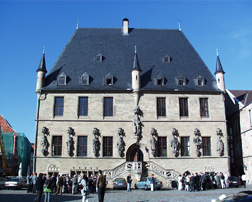Main content
Top content
More about Osnabrück
Regional significance
With a population of about 165,000, Osnabrück is a key location in western Lower Saxony. As a diocese as well as a university and industrial city, it is of great regional significance.
As the center of an economic region of about 1.2 million inhabitants, Osnabrück has always played a leading role in Lower Saxony. The third-largest city in Lower Saxony owes its existence to Charlemagne and his propitious choice of the site more than 1200 years ago. In 780, he founded a diocese at the intersection of ancient trade routes. Even to this day, this is a crossroads for routes from Scandinavia to Western Europe and from the Netherlands to Eastern Europe.
Art and culture
If you’re interested in culture, you’ll find a great deal of it in Osnabrück. The large Municipal Theater (Städtische Bühnen), the studio-sized emma theater and OsnabrückHalle offer extensive theater and concert programs.
The Osnabrück Symphony Orchestra also enjoys a good reputation beyond the city limits.
Those interested in the visual arts will find an excellent museum at the Kunsthalle Dominikanerkirche. The Felix-Nussbaum-Haus is also well worth a visit. It is home to the world’s largest collection of paintings by Nussbaum, a painter born in 1904 in Osnabrück and murdered in Auschwitz in 1944 . Daniel Libeskind’s architectural design for the museum has won international recognition.
The name of Erich-Maria Remarque is also closely connected with Osnabrück. Born in Osnabrück, the author achieved worldwide fame with his 1929 book, "All Quiet on the Western Front". The City awards the Remarque Peace Prize in his honor. Research on Remarque, which has been carried out at the University for many years, led to the 1996 opening of the Erich Maria Remarque Peace Center, an institution jointly sponsored by Osnabrück University and the City of Osnabrück.
Landscape and climate
The City of Osnabrück is located in Lower Saxony (Niedersachsen), the second largest state in the Federal Republic of Germany. Lower Saxony has many different types of scenery, from the North Sea islands with their fresh sea air, to lonely moors and the Harz mountains, featuring winter sports and guaranteed snow. The climate is damp; in summer, temperatures can reach 25°C, and sometimes even higher. Winters can be cold, with occasional snow. There is rain throughout the year. Heavy storms can occur in February and during the fall months, so don’t forget to pack your coat and umbrella!
Tourist Information





